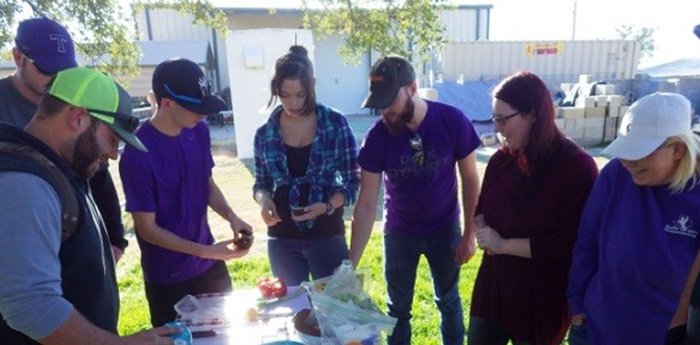
Class WSES 3309
Dr. Hennen Cummings runs an outstanding, challenging, and fun Aquaponics Program on the campus of Tarleton State University. Tarleton State University in Stephenville, Texas, which is 60 miles southwest of Fort Worth, is one of the largest non-land grant agricultural universities in the United States.
The Aquaponics Program curriculum consists of both traditional classroom and lab work as well as practical activities in the greenhouse (Hydrotron), and even includes learning how to prepare meals using ingredients produced in the Hydrotron.
Aquaponics is a sustainable method for growing fish and plants together. Aquaponic systems use fish to fertilize plants, and plants to filter the fish water, in a recirculating loop. An aquaponics system can grow lettuce using 90% less water than a soil-based system.
Students are attracted to aquaponics for a variety of reasons. They like the sustainable nature of growing plants like lettuce in a system where the major inputs are fish, fish food, coco coir, vermiculite, plant seeds, chelated iron, and rain water, and no pesticides or additional fertilizers are needed. Additionally, fish are a great source of protein, and students like that they can produce healthy, fresh food in systems which can be located near cities, reducing the carbon foot print from shipping produce long distances. Students also appreciate that large tracts of land and expensive equipment, often prohibitive costs in starting traditional agricultural operations, are not needed in order to get started in aquaponics. It is amazing to see how much produce can be grown on one square foot when using lettuce towers. Another plus for students is that aquaponics can be performed in a protected environment like a greenhouse with no weeds, fire ants, or pesticides which help contain biocontrol agents like lady bugs and predatory mites.
While aquaponics does not fit the definition of certified organic because it is soilless, the number of pesticides that are appropriate for use in aquaponics is much less than those for certified organic farming because of the requirements of healthy fish. Based on this, it is argued that aquaponics is even better than certified organic farming. It is also more sustainable, considering the reduced water consumption and the ability to have these systems located close to the market place. This shortened shipping time allows for fresher, locally grown produce which then lasts longer and reduces food waste.
The Hydrotron is a greenhouse that includes an aquaponics system and several hydroponics systems. The aquaponics system has a 1750 gallon tank stocked with Mozambique tilapia, a 350 gallon tank with stocked Channel catfish, and a 75 gallon tilapia brood tank. The fish water is recirculated under three 4 ft x 8 ft rafts and several towers where leafy plants use the nutrients in the fish water before the water is returned to the fish tanks. Solid waste filtered from the fish tanks is used to nourish freshwater Tiger prawns in a 950 gallon tank.
Many plants can be grown in the Hydrotron. Tomatoes, peppers, cucumbers, and strawberries are fruiting plants grown in coco fiber (without soil) in hydroponics systems where chemical nutrient fertilizers that are specific to the requirements of each plant species are used instead of fish water due to the higher nutrient requirement of fruiting plants. Strawberries are grown in vertical towers. Herbs in hanging baskets are fertilized with fish water.
Nearby the Hydrotron are several composters and media-based aquaponics systems built by students using stacked 275 gallon Intermediate Bulk Container (IBC) totes. In these stacked IBC systems, the gravel root zone is the filter for the fish, and there are enough nutrients liberated by worms and microorganisms for fruiting plants to thrive in these systems instead of the raft systems where lettuce is grown using just fish water. Fruiting plants need fish solid waste in the root zone, so they grow better in the gravel systems. Onions are also grown outside the Hydrotron.
These systems allow Dr. Cummings to teach primarily with photographs taken during the current semester. During laboratories, students maintain or improve the systems in the Hydrotron to gain practical hands on experience. Having these systems allows students to see the seasonal changes and participate in preventing and solving problems, such as insect herbivory, using methods safe for fish and improving efficiency in production. In labs, students learn a wide array of skills, such as how to design an aquaponics system, how to germinate seeds and transfer seedlings to the rafts/towers, how to prune plants, how to rear fish, and even how to prepare the harvested fish quickly and simply. In addition to providing practical experience for students, the Hydrotron also provides a medium to conduct Aquaponics research on topics such as comparing lettuce grown in BeaverBoards to lettuce grown in two inch net pots.
The Aquaponics Program at Tarleton State University applies the fundamentals, math, techniques, and theories learned both in the classroom and at the Hydrotron, giving students the experience, work ethic, skills, and confidence needed to be successful in establishing and maintaining a 2100 gallon aquaponics system, and four hydroponics systems. It also helps them learn to prevent problems, and practice decision-making, and problem-solving through careful consideration of constraints such as time, season, weather, microclimates, budget, labor, knowledge, priorities, sustainability, politics, water quality and quantity, rainfall, language barriers, patience, product availability, and equipment, as well as understanding the consequences of their decisions.
